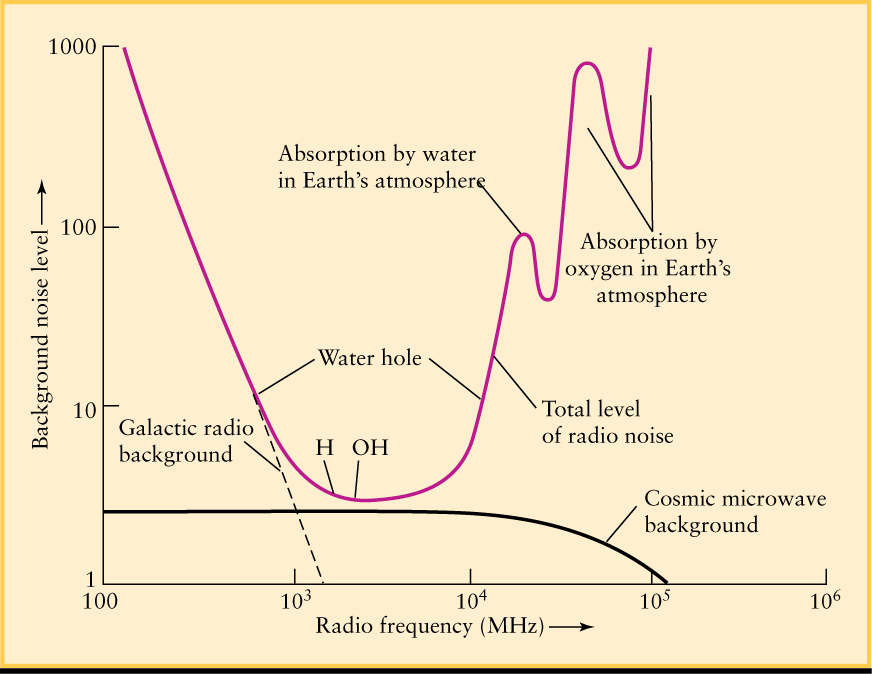27-5 Radio searches for alien civilizations are underway
Even if only a few alien civilizations are scattered across the Galaxy, we have the technology to detect radio transmissions from them. On the one hand, the signals would be too weak to detect if they were similar in strength to the radio waves we use for communication and radio stations here on Earth. Waves like this are like ripples on a pond that diminish as they spread outward. On the other hand, if an advanced civilization wanted to make its presence known, it might sweep the skies with a focused beam of radio waves, which is much easier to detect. Even if we could not decode such a signal, it should be easy to tell that it results from an advanced technology.
But if other civilizations are trying to communicate with us using radio waves, what frequency are they using? This is an important question, because if we fail to tune our radio telescopes to the right frequency, we might never know whether the aliens are out there.
A reasonable choice would be a frequency that is fairly free of interference from extraneous sources. SETI pioneer Bernard Oliver was the first to draw attention to a range of relatively noise-free frequencies in the neighborhood of the microwave emission lines of hydrogen (H) and hydroxide (OH) (Figure 27-12). This region of the spectrum can be called microwave or radio emission and is called the water hole, because H and OH together make H2O, or water.

In 1989, NASA began work on the High Resolution Microwave Survey (HRMS), an ambitious project to scan the entire sky at frequencies spanning the water hole from 103 to 104 MHz. HRMS would have observed more than 800 nearby solar-type stars, but, unfortunately, its funding was cut just one year after becoming operational.
Even though NASA no longer funds searches for extraterrestrial intelligence, several teams of scientists remain actively involved in SETI programs. Funding for these projects has come from nongovernmental organizations such as the Planetary Society and from private individuals. In 1995 the SETI Institute in California began Project Phoenix, the direct successor to HRMS. In 2004, after careful observation of the nearest 800 solar-type stars, scientists for Project Phoenix announced that they had not found any promising signals.
Millions of personal computers have helped scan for alien radio transmissions
A major challenge facing SETI is the tremendous amount of computer time needed to analyze the mountains of data returned by radio searches. To this end, scientists at the University of California, Berkeley, have recruited more than 5 million personal computer users to participate in a project called SETI@home. Each user receives actual data from a detector called SERENDIP IV (Search for Extraterrestrial Radio Emissions from Nearby, Developed, Intelligent Populations) and a data analysis program that also acts as a screensaver. When the computer’s screensaver is on, the program runs, the data are analyzed, and the results are reported via the Internet to the researchers at Berkeley. The program then downloads new data to be analyzed. Since 1999, SETI@home users have provided the equivalent of more than 3 million years of computing time!
In 2007, the SETI Institute began operation of a large radio telescope dedicated to the search for intelligent signals. This telescope, called the Allen Telescope Array (ATA), is actually hundreds of relatively small and inexpensive radio dishes working together. Designed for rapid and sensitive searches, the ATA hopes to search the nearest 100,000 solar-type stars. If astronomers knew which stars had Earthlike planets, SETI’s telescopes could focus their attention on these objects, and the effort to find these stars is underway.
CONCEPT CHECK 27-10
Why should the range of frequencies in the water hole of Figure 27-12 be an attractive range of frequencies for an alien civilization to send out messages?
At other frequencies, there is more background noise, and more energy would need to be used to reliably transmit the same message across the Galaxy. Any advanced civilization could figure this out and would see the benefits of sending messages in this narrow range.